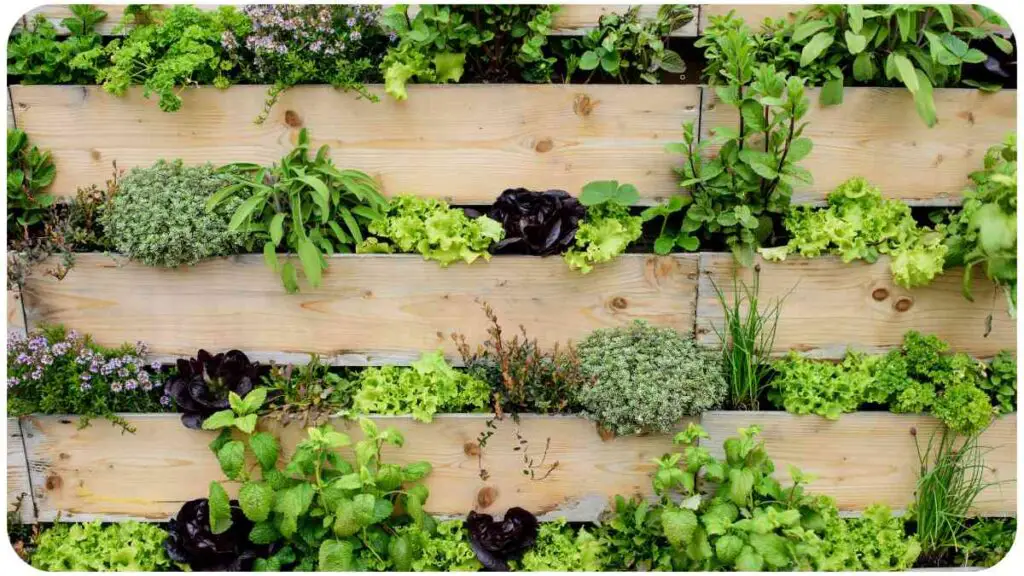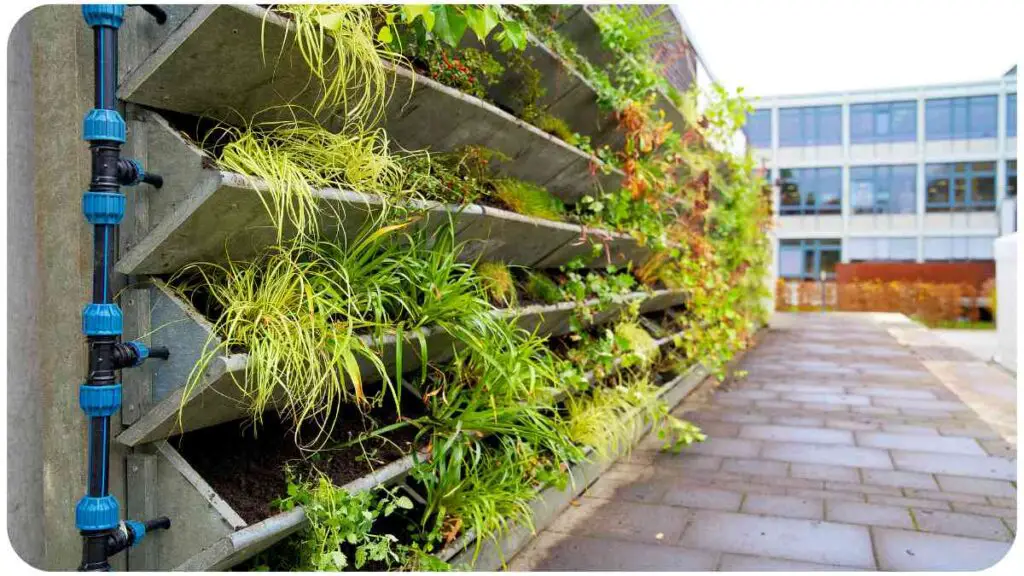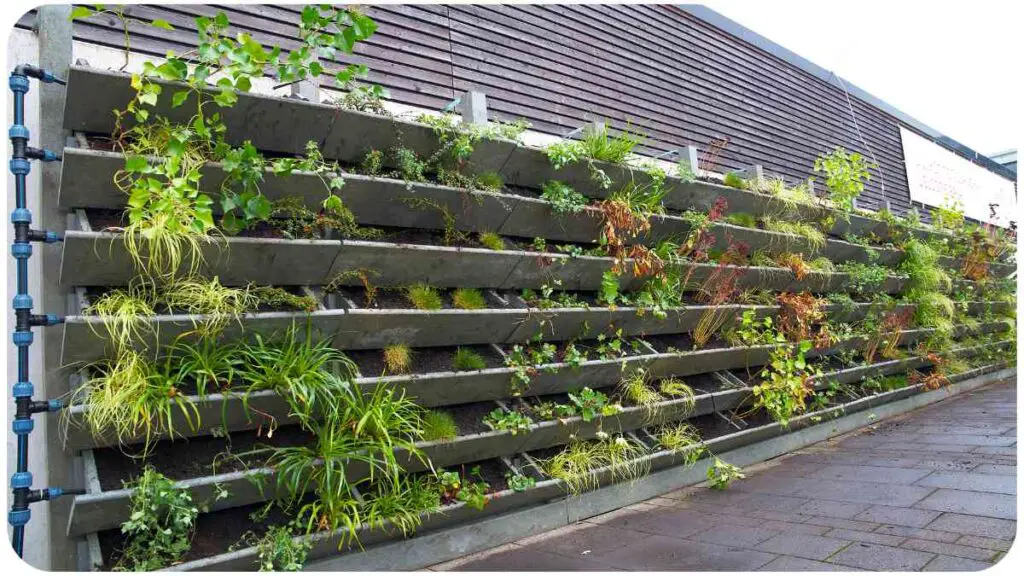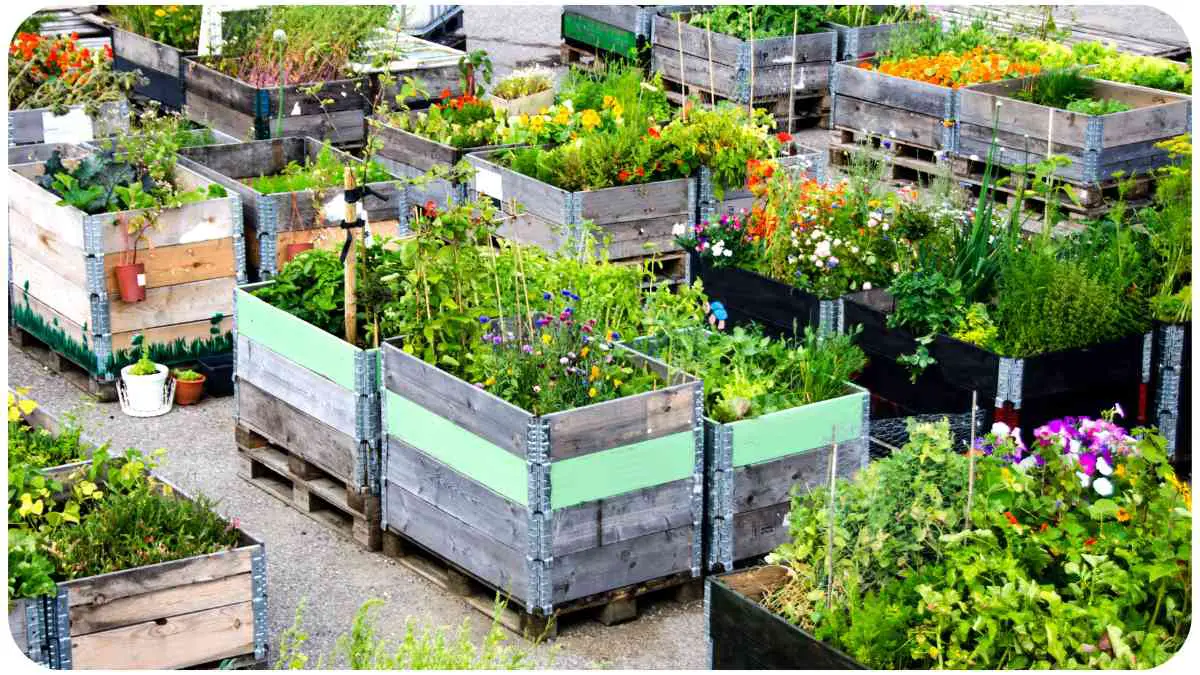Creating a lush, green oasis in the middle of an urban environment can seem like a daunting task, especially when space is at a premium. Enter vertical gardens, the perfect solution for transforming small spaces into vibrant, living walls of beauty and utility.
Whether you’re a seasoned gardener or just getting your hands dirty for the first time, this guide will walk you through the secrets of building and maintaining a thriving vertical garden in even the smallest of spaces.
| Takeaways |
|---|
| 1. Vertical gardens offer numerous benefits, including improved air quality and space optimization in urban environments. |
| 2. Proper planning is essential, from assessing your space and selecting suitable plants to choosing the right structure and watering system. |
| 3. DIY and prefabricated options are available for building vertical gardens, each with its own advantages and considerations. |
| 4. Regular maintenance, including watering, pruning, and pest control, is crucial for the health and longevity of your vertical garden. |
| 5. Vertical gardens can thrive in various spaces, such as balconies, indoors, and outdoors, with careful attention to lighting, soil, and fertilization. |
| 6. By addressing common issues and incorporating creative design elements, you can create a sustainable and visually stunning urban oasis. |
Understanding Vertical Gardens

Benefits of Vertical Gardens
Vertical gardens, also known as living walls, offer a myriad of benefits that go beyond mere aesthetics. They can improve air quality, provide insulation, and even help reduce noise pollution. But the perks don’t stop there. By utilizing vertical space, you can grow a variety of plants in areas where traditional gardening isn’t feasible.
Elevate your gardening with tower and wall gardens, turning limited space into lush greenery.” Maximize Space with Tower and Wall Gardens “Discover the beauty of vertical gardening.
Types of Vertical Gardens
Vertical gardens come in many shapes and sizes, from simple DIY setups to complex prefabricated systems. Here’s a quick overview:
- Wall-mounted Planters: These are individual pots or planters mounted on a wall.
- Pocket Gardens: Fabric pockets that hold soil and plants, perfect for herbs and small flowers.
- Trellises and Arbors: Structures that support climbing plants.
- Modular Systems: Prefabricated panels that can be easily installed and arranged.
Planning Your Vertical Garden
Assessing Your Space
Before you start planting, it’s crucial to assess the space you have available. Consider factors such as sunlight, wind exposure, and the weight-bearing capacity of your walls. Measure the dimensions of the area to ensure that your chosen vertical garden structure will fit.
Choosing the Right Plants
Not all plants are suitable for vertical gardens. You’ll want to select species that thrive in the conditions of your chosen location. For example, shade-loving plants for darker corners or drought-tolerant varieties for sunny spots.
Achieve gardening mastery in small spaces using urban containers for a flourishing oasis.” Small Space Gardening Mastery with Urban Containers “Transform your urban environment into a garden paradise.
Deciding on a Structure
Your choice of structure will depend on your personal style, budget, and the plants you intend to grow. Whether you opt for a DIY project or a ready-made system, ensure it provides adequate support and drainage.
Building Your Vertical Garden

DIY Vertical Garden Ideas
If you’re handy with tools, building your own vertical garden can be a rewarding project. Here are some ideas:
- Pallet Gardens: Repurpose wooden pallets to create a rustic vertical garden.
- Gutter Gardens: Use old gutters to create horizontal rows of planters.
- Hanging Bottles: Recycle plastic bottles by cutting them open and hanging them in tiers.
Using Prefabricated Systems
For those less inclined towards DIY, prefabricated vertical garden systems offer a quick and easy solution. These systems often come with built-in irrigation and are designed for easy installation and maintenance.
Installation Tips
No matter which type of vertical garden you choose, proper installation is key. Here are some tips:
- Secure the Structure: Ensure that your vertical garden is securely attached to the wall or frame.
- Provide Adequate Drainage: Prevent waterlogging by incorporating good drainage into your design.
- Consider Accessibility: Make sure you can easily reach all parts of your garden for watering and maintenance.
Busy urbanites can enjoy low-maintenance gardens without compromising on beauty and greenery.” Creating Low Maintenance Gardens for Busy Urbanites “Experience the joy of hassle-free gardening.
Maintaining Your Vertical Garden
Watering Techniques
Watering a vertical garden can be a bit tricky. You’ll need to ensure that water reaches all plants, including those at the top and bottom. Here are some techniques:
- Hand Watering: Use a watering can with a long spout to reach high and low plants.
- Drip Irrigation: Install a drip irrigation system to provide consistent moisture.
- Self-Watering Systems: Consider using self-watering planters for ease of maintenance.
Pruning and Harvesting
Regular pruning is essential to keep your vertical garden healthy and looking its best. Trim back overgrown plants and remove dead or diseased foliage. If you’re growing edibles, harvest regularly to encourage new growth.
Pest Control
Pests can be a challenge in any garden. Use natural pest control methods, such as introducing beneficial insects or using organic sprays, to keep your plants healthy.
Maximizing Space in Small Areas
Creative Planting Solutions
In small spaces, creativity is key. Think outside the box with your planting solutions. Use vertical garden planters that allow for dense planting and consider mixing different types of plants to maximize visual and functional diversity.
Utilizing Walls and Fences
Walls and fences are perfect for vertical gardens. They provide a sturdy support and can transform a bland surface into a living work of art. Use climbing plants or install planters directly onto these structures.
Incorporating Multi-Tiered Structures
Multi-tiered structures can help you maximize vertical space. These can be simple shelves or more complex tiered planters that allow you to layer plants at different heights.
Best Plants for Vertical Gardens
Herbs and Edibles
Growing your own food in a vertical garden is both rewarding and practical. Some great options include:
| Plant | Light Requirements | Water Needs | Notes |
|---|---|---|---|
| Basil | Full Sun | Moderate | Fast-growing, aromatic |
| Mint | Partial Shade | High | Vigorous grower |
| Strawberries | Full Sun | High | Great for small spaces |
| Lettuce | Partial Shade | Moderate | Quick-growing leafy green |
Flowering Plants
Add a splash of color to your vertical garden with flowering plants. Consider these varieties:
| Plant | Light Requirements | Water Needs | Notes |
|---|---|---|---|
| Petunias | Full Sun | Moderate | Bright, colorful blooms |
| Begonias | Partial Shade | High | Long-lasting flowers |
| Marigolds | Full Sun | Moderate | Easy to grow, vibrant |
Succulents and Cacti
For low-maintenance vertical gardens, succulents and cacti are ideal. They thrive with minimal water and care.
| Plant | Light Requirements | Water Needs | Notes |
|---|---|---|---|
| Aloe Vera | Full Sun | Low | Medicinal properties |
| Sedum | Full Sun | Low | Hardy, drought-tolerant |
| Echeveria | Full Sun | Low | Attractive rosettes |
Vertical Garden Ideas for Different Spaces

Balcony Gardens
Balconies are perfect for vertical gardens. Even a small balcony can be transformed into a lush retreat. Consider using railing planters, hanging pots, or a wall-mounted system. Herbs, flowers, and even small vegetables can thrive in these setups. Here’s a quick tip: use lightweight, compact plants to avoid overloading the balcony structure.
Turn ordinary items into extraordinary planters, adding creativity and charm to your garden.” Transforming Items into Creative Planters “Explore unique ways to showcase your plants.
Indoor Vertical Gardens
Indoor vertical gardens not only enhance the aesthetic of your home but also improve air quality. Use planters that can be mounted on walls or freestanding units that fit against a wall. Choose plants that thrive in indoor conditions, such as pothos, philodendron, or ferns.
Outdoor Vertical Gardens
Outdoor spaces, like patios or garden walls, are ideal for more expansive vertical gardens. You can utilize robust structures and a wider variety of plants. Consider a combination of flowering plants, herbs, and climbing plants to create a dynamic and colorful display.
Watering Systems for Vertical Gardens
Manual Watering
Manual watering is the simplest method, but it can be time-consuming, especially for larger gardens. Use a watering can with a long spout or a hose with a gentle spray nozzle to reach all parts of your garden.
Drip Irrigation Systems
Drip irrigation systems are highly efficient and save time. They deliver water directly to the roots of each plant, reducing water waste and ensuring consistent moisture levels. These systems can be easily installed and customized to fit any vertical garden setup.
Self-Watering Systems
Self-watering systems are perfect for busy gardeners. These systems typically include a reservoir that supplies water to plants over time. They are especially useful for indoor vertical gardens where regular watering can be more challenging.
Lighting Considerations
Natural Light
Most plants thrive on natural light, so position your vertical garden in a spot that receives ample sunlight. South-facing walls are ideal in the Northern Hemisphere, as they receive the most consistent light throughout the day. However, be mindful of overexposure in extremely hot climates.
Artificial Lighting Options
For indoor gardens or spaces with limited natural light, artificial lighting is essential. LED grow lights are energy-efficient and can be tailored to provide the specific light spectrum that plants need for photosynthesis. Position lights to cover the entire garden evenly.
Tips for Optimizing Light
- Reflective Surfaces: Use reflective materials, like mirrors or white walls, to maximize light distribution.
- Adjustable Fixtures: Install lights on adjustable fixtures to change their position as plants grow.
- Light Timers: Use timers to ensure plants receive a consistent light schedule, mimicking natural day and night cycles.
Soil and Fertilization
Choosing the Right Soil
The right soil is crucial for a thriving vertical garden. Use a lightweight, well-draining potting mix that retains moisture without becoming waterlogged. For specific plants, consider a mix designed for their needs, such as cactus soil for succulents or a rich compost mix for vegetables.
Fertilization Techniques
Regular fertilization is necessary to supply nutrients that plants might not get from soil alone. Use a balanced liquid fertilizer or slow-release pellets. Follow the instructions on the product for frequency and application rates.
Prepare your garden to withstand challenges and thrive in any environment.” Building Resilience in Your Garden for Challenges “Ensure your garden’s long-term success and vitality.
Organic vs. Chemical Fertilizers
Organic fertilizers, such as compost or fish emulsion, improve soil health and promote sustainable gardening practices. Chemical fertilizers can provide immediate nutrient boosts but may harm beneficial soil microbes over time. Balance the two approaches or lean towards organic options for long-term garden health.
Troubleshooting Common Issues
Dealing with Overwatering
Overwatering is a common issue in vertical gardens, leading to root rot and mold growth. Ensure your garden has proper drainage and reduce watering frequency if you notice waterlogged soil. Use a moisture meter to check soil moisture levels before watering.
Managing Plant Diseases
Plant diseases can spread quickly in vertical gardens due to the close proximity of plants. Monitor for signs of disease, such as discolored leaves or unusual spots. Remove affected plants immediately and treat with appropriate organic or chemical fungicides.
Addressing Structural Problems
Over time, vertical garden structures may develop issues such as sagging or detachment from walls. Regularly inspect your garden for signs of wear and tear. Reinforce any weak spots and ensure all fastenings are secure.
Inspirational Vertical Garden Designs
Modern Minimalist Designs
Modern vertical gardens often feature clean lines and sleek materials like metal and glass. Focus on a monochromatic plant palette, such as different shades of green, and use geometric planters for a contemporary look.
Rustic and Vintage Styles
For a rustic garden, use materials like reclaimed wood and terracotta pots. Incorporate vintage items, such as old ladders or wooden crates, as plant holders. Choose plants with a more natural, wild appearance.
Creative and Unconventional Ideas
Let your imagination run wild with creative vertical garden designs. Use unexpected items like shoe organizers, PVC pipes, or even rain gutters to create unique planting structures. Mix and match different types of plants for a visually stunning display.
Environmental Impact of Vertical Gardens
Reducing Urban Heat Island Effect
Vertical gardens can help mitigate the urban heat island effect by providing insulation and cooling through evaporation. They reduce the amount of heat absorbed by building surfaces, thus lowering indoor temperatures and reducing energy consumption for cooling.
Improving Air Quality
Plants in vertical gardens absorb carbon dioxide and release oxygen, contributing to cleaner air. Some plants also filter pollutants, improving overall air quality in urban areas.
Promoting Biodiversity
By introducing a variety of plants into urban environments, vertical gardens promote biodiversity. They provide habitats for beneficial insects and birds, contributing to a healthier ecosystem.
Conclusion
Vertical gardens are a versatile and beautiful solution for anyone looking to maximize green space in an urban environment. With careful planning, the right choice of plants, and regular maintenance, you can transform any small space into a thriving, green oasis. Whether you opt for a DIY project or a prefabricated system, the benefits of vertical gardening are well worth the effort. Happy gardening!
Further Reading
For more insights on creating a garden oasis in urban environments, check out these resources:
- How to Create a Garden Oasis in the City
Learn practical tips and ideas for transforming your urban space into a lush, green retreat. - Urban Oasis: How to Make Your Garden More Private
Explore strategies for enhancing privacy in your urban garden, making it a more serene and secluded space. - Urban Permaculture: Green Solutions
Discover sustainable gardening practices and permaculture principles to apply in your vertical garden.
FAQs
What are the best plants for a vertical garden?
Choosing the right plants is crucial for a successful vertical garden. Opt for plants that suit your garden’s light and moisture conditions, such as herbs, succulents, and compact vegetables. Popular choices include basil, mint, strawberries, and petunias.
How do I ensure my vertical garden has proper drainage?
Proper drainage is essential to prevent waterlogging and root rot. Use well-draining soil, ensure your garden structure has drainage holes, and consider adding a layer of gravel at the bottom of planters.
Can I create a vertical garden indoors?
Yes, indoor vertical gardens are a fantastic way to bring greenery into your home. Use planters that can be mounted on walls or freestanding units, and choose plants that thrive indoors, such as pothos, philodendron, or ferns.
How often should I water my vertical garden?
The watering frequency depends on the plants and environmental conditions. Generally, vertical gardens need regular watering, especially in hot and dry weather. Consider installing a drip irrigation system for consistent moisture.
What are some common issues with vertical gardens and how can I fix them?
Common issues include overwatering, pest infestations, and structural problems. To address these, ensure proper drainage, monitor for pests, and regularly check and reinforce your garden structure. Use organic pest control methods and maintain healthy soil conditions to keep plants thriving.

For 15 years, Hellen James has worked in the gardening industry as an expert and landscape designer. During her career, she has worked for a variety of businesses that specialize in landscaping and gardening from small firms to large corporations.

